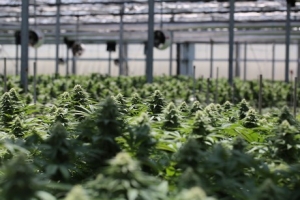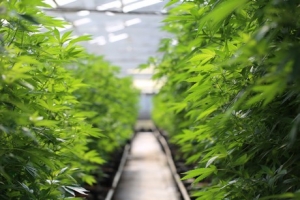Hanna Brand, co-founder of Autumn Brands
“We have a perfect microclimate for growing indoors with natural sunlight”
 Autumn Brands is a licensed California cannabis cultivator based in Santa Barbara, where they grow their cannabis in greenhouses. “We have both a glasshouse and a poly-carbonate greenhouse,” Hanna Brand, co-founder of the company, explains. “This location has been in our family for decades, where we were originally growing flowers, however it’s great for growing cannabis too because we have a perfect microclimate for growing indoors with natural sunlight.”
Autumn Brands is a licensed California cannabis cultivator based in Santa Barbara, where they grow their cannabis in greenhouses. “We have both a glasshouse and a poly-carbonate greenhouse,” Hanna Brand, co-founder of the company, explains. “This location has been in our family for decades, where we were originally growing flowers, however it’s great for growing cannabis too because we have a perfect microclimate for growing indoors with natural sunlight.”
Growing in a greenhouse
The selection of a specific growing environment is usually dictated by a number of factors, one of which being exactly the external weather conditions. Weather and climate are the main factor when choosing a location for any agriculture crop. “Sunlight is a huge reason for our location because growing in a greenhouse means we have the same control as indoor but use natural sunlight instead of grow lights. We can grow year-round without any added lights in our flowering greenhouses, which not only has economic benefits but reduces our environmental impacts.”
No chemical crop protection
 However, when dealing with a greenhouse under the California sun was not the most challenging thing that Autumn Brands had to deal with. “A little over 3 years ago, we made the decision to stop using any chemicals for our crop protection,” Hanna explains. “This meant we completely stopped using any pesticides, herbicides or fungicides and began building a solely biocontrol IPM program. At first it was very difficult because you would lose an entire crop to an outbreak, but we had to be patient and wait for the environment we created to develop.”
However, when dealing with a greenhouse under the California sun was not the most challenging thing that Autumn Brands had to deal with. “A little over 3 years ago, we made the decision to stop using any chemicals for our crop protection,” Hanna explains. “This meant we completely stopped using any pesticides, herbicides or fungicides and began building a solely biocontrol IPM program. At first it was very difficult because you would lose an entire crop to an outbreak, but we had to be patient and wait for the environment we created to develop.”
The IPM regiment of the company now only involves beneficial insects, and the effects on the final products could be spotted immediately.
“Now you will find beneficial insects in all stages of our growth,” she points out. “It is just so nice when you enter your greenhouse, and you see ladybugs flying around and thriving in our environment, which is also a demonstration of how clean the grow room really is.”
The importance of sustainability
By utilizing the sunlight, Autumn Brands not only cut down the operational cost, but it also pursues sustainability. “We have also pushed to use sustainable practices and be environmentally friendly in all stages of our operation,” Hanna says. “For instance, we use a closed loop watering system to ensure there is no run-off and the water is recycled and won’t end up in the environment. Additionally, all of our green waste is picked up and turned into mulch or compost at an approved location.”
Greenhouse vs indoor
 Thus, it seems there are many benefits to growing cannabis in a greenhouse rather than in a closed indoor facility. “A greenhouse is the perfect environment to grow cannabis,” Hanna observes. “It is an indoor grow with full control of the environment but you use the natural sunlight so the cost is lower, environmental impact is lower: nothing is better for a plant than the real sun. If you grew indoors, you wouldn’t have any windows for fresh air, which, if you get a pest issue, it migh very easily spread though your whole grow, so it is very important to filter properly. Indoors, it is potentially easier to control the environment and the growing conditions. However, if you are experienced enough and can successfully manage a greenhouse, then it is almost a no brainer. We relied on many experts from horticulture, trial and error, and we took care of all the smallest details that allow a large-scale agricultural operation to thrive. In our greenhouses, we manage to achieve the same level of control that you would have in an indoor setting.”
Thus, it seems there are many benefits to growing cannabis in a greenhouse rather than in a closed indoor facility. “A greenhouse is the perfect environment to grow cannabis,” Hanna observes. “It is an indoor grow with full control of the environment but you use the natural sunlight so the cost is lower, environmental impact is lower: nothing is better for a plant than the real sun. If you grew indoors, you wouldn’t have any windows for fresh air, which, if you get a pest issue, it migh very easily spread though your whole grow, so it is very important to filter properly. Indoors, it is potentially easier to control the environment and the growing conditions. However, if you are experienced enough and can successfully manage a greenhouse, then it is almost a no brainer. We relied on many experts from horticulture, trial and error, and we took care of all the smallest details that allow a large-scale agricultural operation to thrive. In our greenhouses, we manage to achieve the same level of control that you would have in an indoor setting.”
The shift to a completely natural way to fight cannabis pests and pathogens has set Autumn Brands apart from others.
“Being 100% pesticide free has made a huge different in our final product and the consumers are noticing and giving us positive feedback.” Hanna remarks. “I think that consumers are going to be more product-savvy, and are going to be way more educated. People want to know where their products are coming from, how they were grown and who grew them, this is where I think we can really stand out.”
